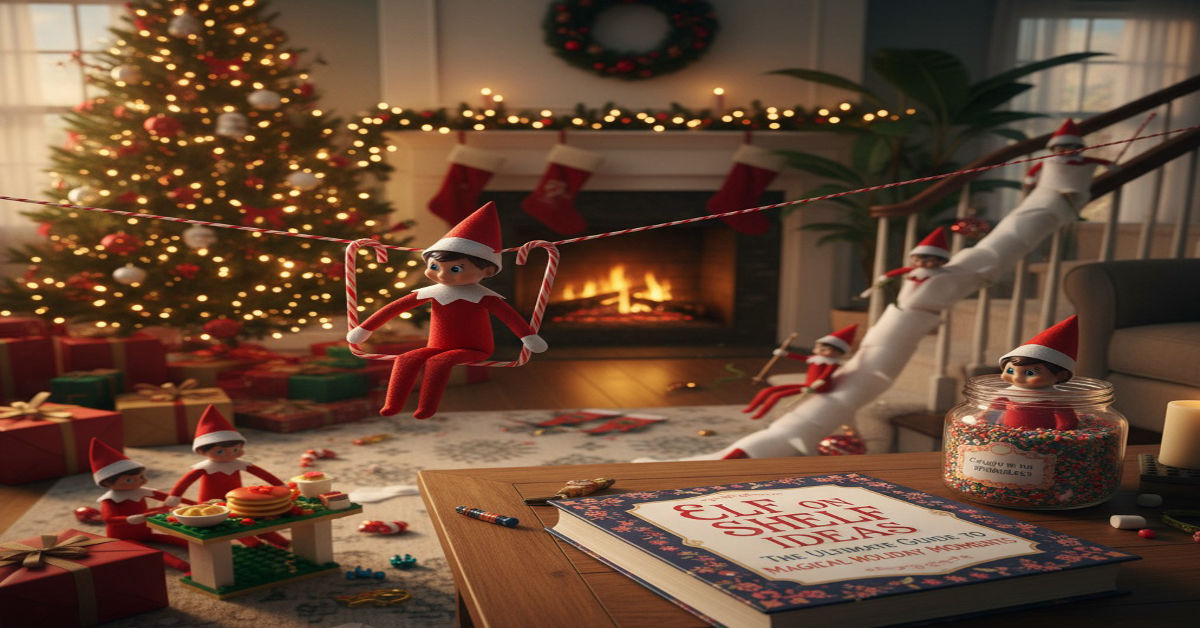Every December homes across the world become stages for an enchanting tradition that fills mornings with laughter and wonder. The Elf on the Shelf has become a holiday icon, captivating the imagination of children and creating joyful anticipation throughout the festive season. This playful elf doesn’t just move around each night; it inspires creativity, storytelling, and connection among family members. Parents become secret directors of nightly surprises, while children wake up eager to uncover what their mischievous little guest has done next.
This guide explores a wide range of elf on the shelf ideas that are not only entertaining but also meaningful. You’ll discover inventive scenes, simple setups and clever ways to weave kindness, humor and learning into the season. Whether you’re a parent starting this tradition for the first time or someone looking to refresh your ideas, this article will help you plan your elf’s journey with creativity and ease.
The Story Behind the Elf on the Shelf Tradition
The Elf on the Shelf story began in 2005 with the children’s book The Elf on the Shelf: A Christmas Tradition by Carol Aebersold and Chanda Bell. It introduced the world to a scout elf sent from the North Pole to watch over children and report their good deeds to Santa Claus each night. When morning arrives, the elf is found in a new spot, sparking delight and curiosity in little hearts. Over the years, this simple idea evolved into a beloved holiday ritual, celebrated by millions of families across the globe.
The tradition endures because it combines two things children adore—imagination and surprise. The elf becomes more than a decoration; it transforms into a companion that makes December mornings feel magical. Modern parents have reinvented the tradition to suit their family’s values, using the elf to encourage kindness, gratitude, and laughter rather than just monitoring behavior. This balance of fun and meaning keeps the tradition relevant and cherished each year.
Why Families Love the Elf on the Shelf
Parents appreciate that the elf provides a chance to spark creativity in children. Every night’s setup becomes a canvas for imagination, and kids naturally engage in storytelling when they discover what the elf has been up to. The excitement also motivates children to wake up early, creating cheerful mornings that contrast beautifully with the usual rush of the season.
Beyond fun, the elf helps build family connection. It becomes a shared experience where laughter and wonder replace the pressures of daily life. The elf’s antics also serve as gentle reminders about kindness, helpfulness, and empathy. Many families find ways to tie the elf’s activities to giving back, making this more than just entertainment. For ideas on nurturing family traditions, you can explore resources from the American Psychological Association, which discusses how shared rituals strengthen relationships.
Preparing for Your Elf’s Arrival
Before your elf makes its debut, preparation is key. Decide when the elf will arrive—most families start on December 1 and continue until Christmas Eve. Pick a consistent time for moving the elf, usually after the children are asleep. Having a plan will reduce late-night stress and allow you to enjoy the process rather than scramble for last-minute ideas.
It also helps to gather a small box of props, mini accessories, and notes ahead of time. Items such as mini-marshmallows, twine, paper cups, flour, and small boxes can be repurposed for countless scenes. Create a simple calendar of ideas so you’re never caught off guard. For inspiration, browsing Good Housekeeping or Parents Magazine can provide helpful creative sparks while ensuring family-friendly activities.
First-Day Arrival Ideas That Create Excitement
The first appearance of the elf sets the stage for the whole season. It’s your opportunity to make a lasting impression that ignites anticipation. One charming idea is to have the elf arrive in a decorated box labeled “Special Delivery from the North Pole.” Add a sprinkle of fake snow or cotton and a tiny letter introducing the elf by name. Another option is to suspend the elf mid-air with a piece of fishing line, as if it’s parachuting into the house from Santa’s sleigh.
Families often use the first day to introduce a mini “Elf Adoption Certificate” or a personalized letter from Santa. These details add depth to the story and help children feel personally connected to their new visitor. The first day doesn’t need to be complicated—what matters most is the sense of wonder it creates. For printable certificates and templates, check out Scholastic’s Family Resources for educational holiday materials.
Mischievous Elf on the Shelf Ideas for Endless Laughter
Mischief is at the heart of the elf tradition, and these ideas never fail to make mornings more exciting. One popular setup features the elf tangled in Christmas lights, as if caught mid-decoration. Another classic is the elf making “snow angels” out of flour or sugar on the kitchen counter. Parents love these ideas because they’re quick to arrange yet guaranteed to make kids giggle.
You can also create elaborate scenes such as the elf having a marshmallow bubble bath in the sink or hosting a toy car race with action figures. The humor keeps children engaged and builds anticipation for the next reveal. Below is a quick-reference table to inspire your nightly planning.
| Scene Theme | Description | Setup Time | Laughter Rating |
| Marshmallow bath | Elf sitting in a bowl filled with mini-marshmallows | 10 minutes | 9/10 |
| Snow angel scene | Flour sprinkled on counter with angel imprint | 8 minutes | 8/10 |
| Wrapped presents | Elf tangled in wrapping paper | 12 minutes | 9/10 |
| Zip-line adventure | Elf sliding down ribbon between chairs | 15 minutes | 10/10 |
| Toy takeover | Elf surrounded by toys planning a “coup” | 10 minutes | 7/10 |
These playful displays capture the joyful essence of the season while remaining easy enough for parents to pull off during busy nights.
Heartwarming and Educational Elf on the Shelf Ideas
While laughter matters, the elf can also become a messenger of kindness. Parents often use the elf to promote gratitude and compassion. One idea is to have the elf leave “kindness cards” each morning, encouraging children to perform small good deeds like helping a sibling or donating an unused toy. Another educational twist is transforming the elf into a “science scout,” bringing mini experiments or trivia notes about the North Pole and winter weather.
These thoughtful scenes make the tradition meaningful, teaching values beyond fun. They also align perfectly with research from the Harvard Graduate School of Education on how shared family rituals enhance children’s emotional development. Incorporating kindness, learning, and curiosity transforms the elf into a positive influence rather than just a mischievous visitor.
Low-Prep Elf on the Shelf Ideas for Busy Parents
Not every day requires a complex scene. Life gets hectic, and the best elf setups are often the simplest. You can place the elf inside a coffee mug with a note that says “Need caffeine for toy-making!” or have it relaxing in a tissue box “bed.” On busy mornings, the elf can even remain in one spot with a message about needing rest after a long trip to the North Pole.
Low-prep ideas keep the tradition consistent without overwhelming you. Another effortless favorite is the “cereal surprise,” where the elf hides inside a cereal box peeking through the flap. These setups take only minutes but continue to delight children. Consistency matters more than complexity—your child will remember the laughter, not the effort behind it.
Creative Props and Materials Table
To keep your nightly routines smooth, it helps to have a small “Elf Kit” ready with everyday materials. The table below lists versatile items you can use across multiple setups.
| Material | Possible Use | Difficulty | Reusability |
| Balloons | Arrival scenes or party setups | Easy | High |
| Flour or sugar | Snow effect for kitchen scenes | Medium | Low |
| Mini craft items | DIY elf props like tools or gifts | Medium | High |
| String or tinsel | Zip-lines and climbing scenes | Medium | High |
| Paper cups | Tunnels, forts, or sleds | Easy | High |
| Toy blocks | Platforms or obstacle courses | Easy | High |
| Printed notes | Letters, certificates, or clues | Very easy | High |
Organizing a small box with these materials ensures you can quickly build engaging scenes even when time is short. This approach saves both stress and money during the busy holiday season.
Themed Elf on the Shelf Ideas by Age Group
Every child interacts differently with the elf depending on their age and personality. Tailoring your ideas makes the experience more memorable Elf on the Shelf Ideas. Toddlers love colorful, simple scenes such as the elf sitting among building blocks. Early school-age children enjoy humor and mild mischief, like finding the elf “fishing” in the sink with a candy cane rod.
Pre-teens prefer puzzles or small challenges—perhaps the elf leaves a riddle to solve each morning. For older kids and families, you can add technology twists like using a phone flashlight to “spotlight” where the elf landed. The table below provides quick reference for tailoring ideas.
| Age Group | Style | Example Setup | Engagement Level |
| Toddlers | Visual and gentle | Elf peeking from stuffed animals | High |
| Early School | Playful and silly | Elf sliding on banister | Very High |
| Pre-Teens | Interactive puzzles | Elf with clue to treasure hunt | High |
| Teens & Families | Inside jokes or minimal setups | Elf watching a movie with popcorn | Moderate |
Matching the complexity and humor to your child’s stage helps maintain enthusiasm throughout the season.
Safety and Practical Tips for Parents
Even though the elf tradition is fun, it’s important to keep safety in mind. Avoid placing your elf on high ledges or unstable shelves that could cause falls. For younger children, skip any props small enough to pose a choking hazard. Cleaning up messy flour or water setups quickly also prevents slips or sticky counters.
Another practical tip is to schedule “elf rest days.” When you need a break, simply leave a note saying the elf had to report to Santa overnight. This builds flexibility without disappointment. Parenting experts from the Mayo Clinic emphasize balance and realistic routines for family harmony—your elf activities should bring joy, not stress.
Conclusion and Holiday Inspiration
The Elf on the Shelf is more than a seasonal decoration—it’s a storytelling tradition that unites families through imagination and laughter. Whether you craft elaborate adventures or keep it simple, every moment spent planning adds to your family’s holiday memories. The key is to make it enjoyable, personal, and flexible so that it complements your household rhythm.
As you prepare your own elf journey this year, remember that magic lives in small gestures. A few thoughtful ideas can transform ordinary mornings into moments of joy. Use these ideas as a springboard to create your own unique stories, filled with laughter, kindness, and holiday spirit. May your home sparkle with creativity, and may your elf continue to bring smiles year after year.
Frequently Asked Questions
When should the elf arrive?
Most families welcome the elf around December 1, but there’s no strict rule. Choose a date that fits your household schedule and energy.
Can children touch the elf?
Traditionally, the elf loses its magic if touched, but families can adapt this rule. Some parents use “magic gloves” so kids can move the elf safely when necessary.
What happens if the elf doesn’t move one night?
Simply leave a note explaining that the elf had to visit Santa or was too tired from travel. Kids often find these explanations endearing.
How do I handle multiple children?
Give each child a small role—perhaps writing a daily note back to the elf or helping with a kindness activity. This inclusion fosters cooperation rather than competition.







